Fall can mean a lot of things: a beautiful mosaic of changing leaves, the fast approach of spooky season, or maybe even the opportunity to drink pumpkin spice everything. For us at EcoShield, we have one fall-weather topic on our mind: overwintering pests. As the weather continues to cool, the potential for unwanted pests seeking reprieve from the cold grows each day. There are many pests that overwinter indoors, but none as hair-raising for our homeowners as spiders. When spiders make their way indoors in droves, we often get the exasperated question: “how much to get rid of these things?!” In this article, we’ll discuss the cost of keeping your home spider-free this fall and winter seasons.
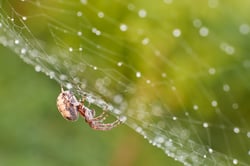
What are spiders vs. arachnids?
To better understand what you’re up against, it’s important to learn about the “enemy.”
Spiders are a vast group of arachnids that are classified as anthropoids. This class is not only made up of the typical spiders you’d expect but also scorpions, mites, and ticks. There are over 45,000 known species of spiders that span the globe and thrive in a variety of habitats. For the purposes of this article, we will be focusing on spiders that are native to the United States.
Spiders can vary greatly in size depending on the species; some can be as small as 0.011 of an inch, while others can have a leg span of nearly a foot! Their appearances don’t range strictly in size, either. Spiders can be practically any color, range in shape, and even vastly differ in hairiness. While spiders have a lot of differences between species, there are some things all arachnids have in common. All spiders have bodies that are divided into two tagmata (segments or sections), eight jointed legs, no wings or antennae, simple eyes, and an exoskeleton.
Another thing nearly all spiders share is venom. Only two small subgroups of spiders lack venom glands, while the overwhelming majority of spiders are considered venomous. That said, just because nearly all spiders are venomous, it doesn’t mean all spiders are a danger to humans. In fact, many common spiders have venom so weak that they are generally regarded as harmless to humans. In such cases, venom is typically only an effective poison for a spider’s prey, not human beings.
A spider’s venom is an important tool in its ability to hunt. A common misconception is that all spiders spin webs to catch their prey – this is simply not true. While all spiders have the capability of producing silk, many spider species do not entrap their prey in webs. Some spiders prefer to hunt in the more traditional sense, where their venom plays a key role in immobilizing their next meal.
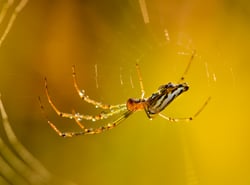
What are common spiders that overwinter indoors?
There are many spider species that overwinter indoors. Some overwinter as adults, waiting out the cold weather in your home, garage, or attic to emerge in the spring. Other adult spiders may lay eggs indoors before they die off, allowing their young to overwinter in a warm environment until they eventually hatch when the snow melts away. Let’s check out a few spiders that you may encounter this overwintering season.
AMERICAN HOUSE SPIDER
Also recognized as the common house spider, the American house spider is only of the most frequently encountered spiders in a home. As the name suggests, these spiders are known for building webs in hidden areas of a home, such as attics, basements, sheds, barns, and even corners of a room. The American house spider is less than a quarter of an inch in size and is brown with occasional white spotting on the abdomen. Males have legs that appear orange-tinted, while females’ legs tend to look yellow. One of the easiest ways to spot an American house spider is by the several dark rings on its legs.
Unfortunately, these spiders are a “frequent flier” all year round and can live their entire lives indoors. They do overwinter in homes, but it’s more likely that they’ve been there all spring and summer long… they were probably even born there!
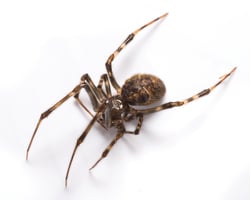
DADDY LONG LEG
Another easily recognizable and frequently sighted arachnid is the Daddy Long Leg. Identified by their small spherical abdomens and extremely long, thin legs, the Daddy Long Leg isn’t actually a spider at all. They make up the order of Opiliones and aren’t a spider but are classified as arachnids (just as ticks, mites, and scorpions are.) Another misconception about these arachnids, or rather a well-accepted myth, is that Daddy Long Legs are the most venomous of all spiders, but their fangs are simply too short to bite humans. This isn’t true for two reasons: first, they’re not spiders at all, and second, they actually don’t have venom glands (or fangs, for that matter.)
Adult daddy long legs can overwinter for up to two years indoors and frequently use this time to mate and reproduce. In especially frigid climates, some adult daddy long legs don’t survive the winter season, but will still lay eggs within homes or structures to stay safe from the chill.
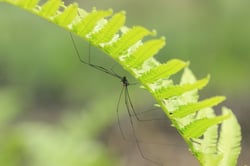
ORB WEAVER
Orb weaver spiders are the most common group of spiral-shaped web builders that are most frequently found in gardens, fields, and forests during the warmer months. Orb weavers are an incredibly large group of spiders that consist of many different spider species, making identification rather difficult. This group is one of the most diverse in appearance, varying in color, size, and shape depending on species. Many orb weavers are bright in color with relatively hairy bodies and spiny legs, but nocturnal species can also be colored black or gray. Perhaps the best way to identify an orb weaver is by their webs themselves, all of which are large and made of many concentric circles connected by spoke-like strands of silk.
Adult orb weaver spiders rarely survive a winter season; however, some immature adults may overwinter indoors and live on to see spring. Female orb weavers may also lay large quantities of eggs indoors wrapped in a thick layer of silk to overwinter and hatch in the spring.
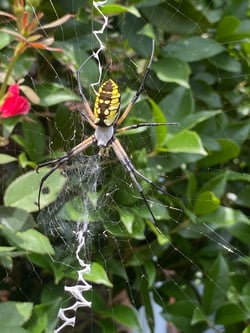
BROWN RECLUSE
The brown recluse is well-known for its venomous bite and unfortunately is the most common of brown spiders. Found from Texas to Florida and up to Ohio, brown recluses are feared for their necrotic venom, which can potentially result in rotting lesions if left untreated. Brown recluses are frequently encountered in homes due to their preferred hiding places. Commonly inhabited spaces include closets, basements, and cellars where the spiders can hide in boxes, clothing, shoes, rubber tires, and other dry, dark, and warm places. Often difficult to identify, brown recluses are rather unassuming in appearance and frequently misidentified as the lesser feared hobo spider. Not particularly large or significantly colored, the best way to spot a brown recluse is by the tell-tale dark brown violin-shaped marking on its back.
Because many brown recluse spiders prefer residing in structures to begin with, many will spend the winter season indoors, likely hidden away in underused areas of the home. Surprisingly, brown recluse spiders are one of the few spiders that actually could survive a winter season outdoors as they are naturally resistant to the cold. Instead, most brown recluses stow away indoors where food and protection are prevalent.
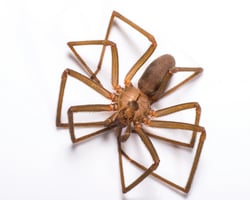
BLACK WIDOW
An equally notorious spider is the black widow, similarly feared for its venom, which is reported to be 15x stronger than a rattlesnake’s. Mostly identifiable by their large black bodies with the infamous red hourglass on their back, the ones who have the most to fear are, in fact, other insects or male black widows. Females have been known to eat their counterparts after mating, giving credence to their ominous name. Despite their violent reproductive habits, black widows are solitary creatures who generally avoid humans and are regarded as nonaggressive. Most black widow bites have been the result of humans accidentally grabbing or sitting on them, provoking the spider to bite in self-defense. The Northern Black Widow Spider is found throughout the eastern US, from southern Canada south to Florida and west to eastern Texas, Oklahoma, and Kansas.
Black widow spiders tend to begin moving indoors around autumn in anticipation of the upcoming freezing temperatures. Most adult black widows will overwinter just once in their lives as their expected lifespan is around one year, but some may live up to 3 years and overwinter a couple of times.
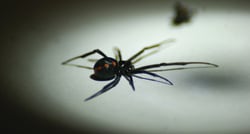
How much does it cost to get rid of spiders in my home?
As you may have come to realize, spiders are an incredibly diverse species made up of a vast array of unique and complex insects. Because of this, there isn’t a one-size-fits-all fix for every spider problem. This is exactly why many DIY attempts at spider removal are either unsuccessful or only temporarily successful. It requires a trained professional to identify the problem pest, determine an effective course of action, and implement further prevention methods to ensure the spiders don’t return. Severe spider infestations may also require follow-up visits to further treat existing spiders and spider eggs, or prevent future spiders from making their way into your home.
Unsurprisingly, pricing for spider removal and prevention can vary from customer to customer, and there is no set price industry-wide for this service. Depending on the severity of the problem and the company/product used for treatment, along with potential follow-up visits and the implementation of prevention tactics, homeowners can expect to pay anywhere from $400-$1500 for spider removal, depending on the size of their home and the level of the infestation.
When selecting a pest control company, it’s important to consider their policies and procedures regarding spider removal. Is their quote an all-in-one price? Do they charge hourly or per visit? Are potential follow-up visits included in the quote? How quickly can they provide service? Are their products safe for people and pets? If the spiders return, how quickly can they come back out before the problem gets worse and requires more costly intervention? And more importantly, do the products they use to treat your home prevent new spiders from entering your home? Or do they just eliminate the spiders they can see during the initial treatment? All of these questions are important to consider when choosing the right pest control provider for you.
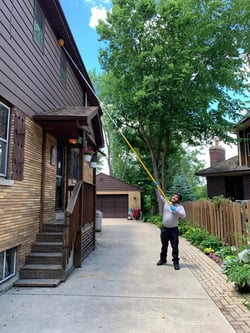
What does EcoShield do for spider problems?
EcoShield offers spider solutions to serve every customer’s specific needs. Not only do we offer one-off spider services for those experiencing time-sensitive infestations, but spider removal and prevention is also included in the Shield Home Protection Plan. This service option includes four-season protection from a variety of pests (including spiders) and is guaranteed effective - if the pests come back, so do we… for free!
When we treat for spiders in your home, our eco-friendly products will also take care of other pests such as ants and other nest insects. When a spider squeezes through cracks in doors or a windowsill, it rubs its body across the products we use, and in a few days, the spiders will be eliminated and will offer long lasting protection against spiders in your home.
Spider removal will begin with an initial service consultation in which a trained EcoShield pest technician will identify and evaluate the severity of the problem at hand. Our expert professionals thoroughly inspect the existing evidence of problem spiders, but also check for unidentified problem areas, points of entry, and other concerns. During this visit, you will receive a free no-obligation quote to rectify your spider infestation quickly.
If you experience a problem with overwintering spiders in your home, give EcoShield a call immediately for safe, effective, and expert removal. You may also fill out the contact form on this page and our expert technicians will help ensure your home is free from pest-related concerns. Our Shield Home Protection plan is guaranteed to eliminate and prevent spiders from entering your home and provides year-round protection. If you are a customer and are experiencing spiders in your home, just give us a call and we'll come out and treat your home for free!
